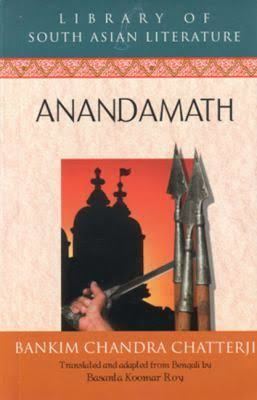8 /10 1 Votes
Original title আনন্দমঠ Publication date 1882 Media type Print (Paperback) Genre Novel | 4/5 Goodreads Published in English 2005, 1941, 1906 Originally published 1882 Adaptations Anand Math (1952) Original languages Hindi, Bengali | |||||||||||||||||||||||||||||||||
 | ||||||||||||||||||||||||||||||||||
Similar Bankim Chandra Chattopadhyay books, Novels, Indo-Aryan languages books | ||||||||||||||||||||||||||||||||||
Bankim chandra s anandamath the beginning
Anandamath (Bengali: আনন্দমঠ Anondomôţh; first English publication title: The Abbey of Bliss) is a Bengali fiction, written by Bankim Chandra Chatterjee and published in 1882. Set in the background of the Sannyasi Rebellion in the late 18th century, it is considered one of the most important novels in the history of Bengali and Indian literature. Its importance is heightened by the fact that it became synonymous with the struggle for Indian independence from the British Empire. The novel was banned by the British. The ban was lifted later by the Government of India after independence.
Contents
- Bankim chandra s anandamath the beginning
- Plot summary
- Characters
- Commentary
- Historical accuracy
- Film adaptation
- References
The national song of India, Vande Mataram, was first published in this novel.
Plot summary
The book is set in 1771 during famine in Bengal (see Famine in India, for more information about famine in India under the British regime). Book starts with introduction to a couple- Mahendra and Kalyani, who are stuck at their village Padachina without food and water in the times of famine. They decide to leave their village and move to the next closest city where there is a better chance of survival. During the course of events, the couple got separated and Kalyani had to run through the forest with her infant, to avoid getting caught by man-hunters. After a long chase, she loses consciousness at the bank of a river. A Hindu monk, Satyananda, stumbles upon her and the baby, and takes care of her till she reunites with her husband again.
Mahendra at this point is more inclined towards joining the brotherhood of the monks and serving the Mother Nation. Kalyani wants to help him in attaining his dreams by trying to kill herself, thereby relieving him of worldly duties. At this point, Satyananda joins her but before he can help her, he is arrested by the British soldiers, because other monks were fuelling revolt against the British rule. While being dragged away he spots another monk who is not wearing his distinctive robes and sings,
"In mild breeze, by the bank of the river,
In the forest, resides a respectable lady."
The other monk deciphers the song, rescues Kalyani and the baby, taking them to a rebel monk hideout. Concurrently, Kalyani's husband, Mahendra, is also given shelter by the monks, and they are reunited. The leader of the rebels shows Mahendra the three faces of Bharat-Mata (Mother India) as three goddess idols being worshipped in three consecutive rooms:
- What Mother Was – An idol of Goddess Jagaddhatri
- What Mother Has Become – An idol of Goddess Kali
- What Mother Will Be – An idol of Goddess Durga
Gradually, the rebel influence grows and their ranks swell. Emboldened, they shift their headquarters to a small brick fort. The British attack the fort with a large force. The rebels blockade the bridge over the nearby river, but they lack any artillery or military training. In the fighting, the British make a tactical retreat over the bridge. The Sannyasis undisciplined army, lacking military experience, chases the British into the trap. Once the bridge is full of rebels, British artillery opens fire, inflicting severe casualties.
However, some rebels manage to capture some of the cannons, and turn the fire back on to the British lines. The British are forced to fall back, the rebels winning their first battle. The story ends with Mahendra and Kalyani building a home again, with Mahendra continuing to support the rebels.
The national song of India i.e. Vande Mataram is taken from this novel.
Characters
Commentary
The plot background was loosely based on the devastating Bengal famine of 1770 and unsuccessful Sannyasi rebellion. Bankim Chandra dreams of an India rid of the British. In this dream, he imagined untrained Sannyasi soldiers fighting and beating the highly experienced British Army. Despite the romanticism, the novels patriotism was a significant voice amidst the oppression of British rule and the struggle for Independence.
Historical accuracy
In the novel, Muslims are portrayed as the enemies although the British had already started ruling Bengal. It has been said by leftist historians that Bankim’s inaccurate accounts in this novel could only be explained by his political aspiration for a moral and cultural atmosphere in which the politics of Hindu nationalism could flourish. Ahmed Sofa criticizes him for not recognizing Muslim contributions in the Sannyasi Rebellion, particularly the role of Majnu Shah.
Film adaptation
The novel was later adapted into a film, Anand Math in 1952, directed by Hemen Gupta, starring Bharat Bhushan, Pradeep Kumar and Geeta Bali. Music was by Hemant Kumar, who gave a version of the Vande Mataram, which became a cult success.
